Identifying Key Diseases in Corn
January 14, 2020
Corn has to survive a number of disease threats throughout the season, such as gray leaf spot, northern corn leaf blight, tar spot and common and southern rust. Managing these diseases early is essential to keeping your corn crop healthy and protecting your yields.
Management for field corn, sweet corn and seed corn plant diseases is achieved through an integrated approach of best management practices and use of foliar fungicides and fungicide seed treatments.
Knowing what these diseases look like is the first step in prevention and protection. Use our scouting guide to catch key diseases and consider using a fungicide with three modes of action, such as Delaro® Complete fungicide.
Corn Leaf Diseases
Numerous corn diseases, including those caused by fungi and bacteria, exhibit symptoms in the leaves. Fungal and bacterial inoculum can overwinter in crop residue on the soil surface and/or be spread by wind and water. Certain other pathogens must have a living host to overwinter, and spores must be carried on wind currents for new infections.
Foliar diseases that establish prior to tasseling, or become severe within two to three weeks after tasseling and pollination, can result in significant yield loss. Major diseases affecting the leaf include:
Gray leaf spot
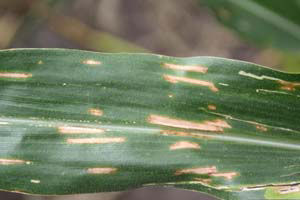
Gray leaf spot is the number one disease in all corn production. The fungus survives the winter on residue from the prior corn crop, providing a primary source of the inoculum, particularly when growers plant continuous corn or use a no-till soybean/corn rotation. Spores from the fungus are splashed onto the lower leaves early in the season. When these resulting infections produce spores, the inoculum can be carried by air currents higher into the canopy or into neighboring fields. Mature lesions from gray leaf spot are rectangular, as they are restricted by the leaf veins.
Northern corn leaf blight
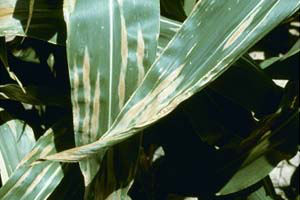
Similar to gray leaf spot, the fungal inoculum causing northern corn leaf blight survives in the residue in the soil and moves up through the canopy. This disease differs from gray leaf spot, however, in that it prefers cooler conditions, tending to strike the corn crop later in the season.
Northern corn leaf blight is easily identified by the 1- to 6-inch cigar-shaped lesions on lower leaves, which may be grayish-green to tan in color.
Common rust
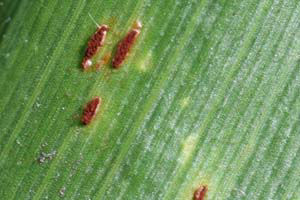
Common rust is found everywhere in corn production. Both seed corn and sweet corn are very vulnerable to common rust, although the disease is not usually an economic problem in field corn. It tends to become less aggressive as the weather turns hot and dry.
Common corn rust, caused by Puccinia sorghi, appears as small, oval dark-reddish-brown pustules scattered over both surfaces of corn leaves.
Southern rust
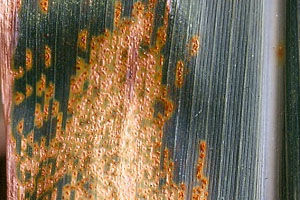
Because of the changes in hybrid genetics over the last few years, southern rust has become more problematic. It has begun to spread all across the corn-growing region, starting in the South and being windblown to the North.
Southern rust differs from common rust in that it thrives in hot conditions. As common rust starts backing off, southern rust explodes.
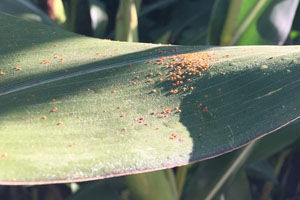
Southern corn rust, caused by Puccinia polysora, erupts in orange to brown masses of spores. Southern corn rust almost exclusively sporulates on the top of the leaf. This is one of the best ways to distinguish between the two types of rust.
Anthracnose
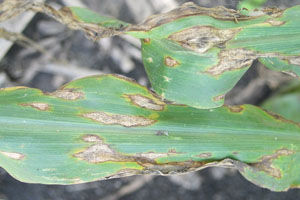
This fungal disease, which attacks the plant at various stages of growth, can appear early in the season as a leaf blight. Later, anthracnose can attack the stalks above the ear leaf leading to “top dieback,” or lower on the stalk soon after tasseling leading to reduced plant productivity and lodging.
Anthracnose leaf blight produces oblong, water-soaked lesions up to 6 inches long, with tan centers and brown borders. They appear on lower leaves early in the season and develop on the upper leaves late in the season.
Eyespot
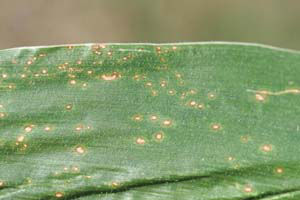
Eyespot, a fungal disease that overwinters on surface corn debris, can be a severe problem. Early symptoms include small, light green, circular lesions with yellow halos. Lesions develop brown/purple rings as they age and may merge, destroying larger areas of leaf tissue.
Southern corn leaf blight
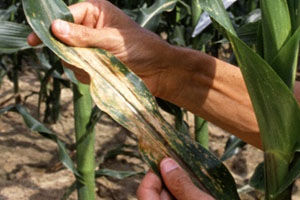
Southern corn leaf blight lesions on leaves are seen at the mid-whorl stage through maturity. This fungal disease favors wet conditions and warm temperatures, as well as reduced tillage and continuous corn production.
Symptoms of southern corn leaf blight progress into long, oblong, tan or grayish lesions.
Tar spot
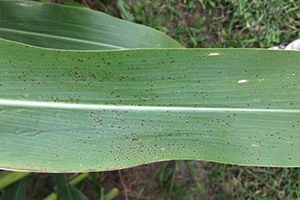
Caused by the fungus Phyllachora maydis, tar spot was first confirmed in the United States in 2015 in Indiana and Illinois.
Tar spot thrives in cool, wet and humid conditions with long periods of wetness. The primary symptom is small, raised, circular black spots on the leaves of the infected corn crop. Tar spot can mimic common and southern corn rusts, but tar spot lesions cannot be rubbed or scraped off like rust pustules.
Corn Stalk Diseases
Infection by most stalk rot organisms, both fungal and bacterial, can occur early in the season. Infection, however, becomes obvious during grain fill. Stalk rots can cause significant yield loss when the disease causes plants to deteriorate prematurely, resulting in poor ear fill or light test weight grain. Lodging can also cause heavy yield losses.
Many stalk rot diseases first infect the roots and then progress into the lower stalk. These diseases plug the vascular tissue in the stalk, limiting the uptake of water and nutrients from the soil, causing a significant impact on overall yield and test weight. They are also critical because they impact the strength and vitality of the stalk; the weakened stalk can tip over and cause lodging. The occurrence and severity of stalk rot diseases depend on many factors, such as plant stress.

Anthracnose is a major stalk rot disease, causing problems in many types of corn and notable for attacking the plant at various stages of growth. It appears early in the season as a leaf blight. Later in the season it is visible in stalk dieback; the top parts of the stalk often snap off because the vascular tissue is plugged and the stalk is rotting at the top. It enters through the roots and invades the lower section of the plant, but it can also invade the stalk itself.
The stalk rot phase of corn anthracnose is distinctive. Black streaks and blotches, sometimes covering the entire stalk, appear on the surface of the lower stalk late in the season. The stalk surface usually has a glossy shine. The pith also becomes shredded, turning dark gray to brown.
Other significant stalk rots include Fusarium stalk rot, Gibberella stalk rot, Diplodia stalk rot, charcoal rot and bacterial stalk rot.
Corn Seed and Seedling Diseases
Several different soilborne or seedborne fungi in corn can cause seed and seedling rots, also called pre- and postemergence damping-off. These early diseases can rot seed, reduce emergence, slow growth and stunt plants, thereby reducing yield.
Rhizoctonia
Rhizoctonia root rot can discolor and decay the outer layer of the main root and stem at the soil line and below. Rainfall, followed by cool and then warm, humid weather, is conducive to development of this disease.
Managing Corn Diseases
A well-thought-out disease-management program, including best management practices, proper seed protection and selection, and fungicide applications using multiple modes of action should be implemented to sustainably manage corn diseases.
A seed treatment provides great protection against early fungal diseases, especially in cool and damp spring conditions, and helps plant seedlings get off to a vigorous start. Also, timely fungicide applications, including foliar fungicides, help protect corn plants from fungal diseases throughout the season. For growers, a fungicide decision is a matter of considering production needs, risk management, timing of various agronomic practices and an eye to commodity prices.
What is Delaro® Complete Fungicide and how does it work?
Delaro Complete contains three active ingredients. The first, fluopyram, is a group 7, or SDHI, which has activity on important soybean diseases including white mold, brown spot and offers plant health benefits. The second, prothioconazole, is a group 3, or triazole, which has a very broad and deep spectrum of disease control and activity. The third, trifloxystrobin, is a group 11, or strobilurin, that shows preventative activity on many diseases, and also offers benefits to plant health. These powerful ingredients work together to provide consistent control of most major corn and soybean diseases and increased plant health all season long. Delaro Complete Fungicide diffuses in and on the waxy surface of the plant. It then expands protection across the plant's exterior by moving via surface moisture, such as dew. Within the plant, Delaro Complete Fungicide is transported systemically throughout plant tissue for enhanced coverage.
